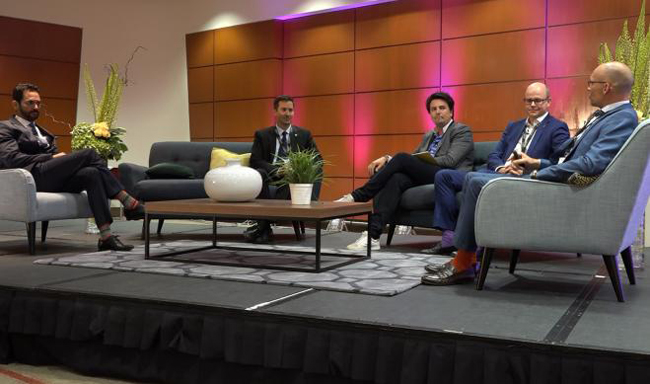
By Stuart Pallister, EHL Hospitality Insights
When it comes to the serviced apartment sector, as land prices rise, the trend is for smaller size units – and that’s posing a challenge for designers: what to keep within the room or apartment, and what to move into possible communal areas.
In a panel discussion held at the Serviced Apartment Summit Europe (#SASEU) staged in London, business development executives from SACO, BridgeStreet, Adagio and Frasers discussed the sector’s current directions in the context of innovation and concept development.
Eric Jafari, Managing Director of SACO Apartments, acknowledged that, from a design perspective, the sector used to be “probably 20 years behind hotels” in terms of guest experience, however it has accelerated rapidly in the last few years.
According to Marcel Lindt, the director of business development in the EMEA region for Frasers Hospitality UK, the sector has seen a change in demand. Ten years ago, the whole family would stay for three months in a three-bedroom apartment. Now it’s an individual who stays for a few weeks in a studio apartment.
As demand has changed, so too has supply. Many aparthotels are now focusing on providing small, functional rooms with a bed and a shower. Kitchens are being moved into communal areas. “The rooms have become more compact,” Lindt said.
Aparthotels Adagio is “thinking about squeezing all the room space,” said Baptiste Valois, who is in charge of the concept and design of Adagio products. “Nowadays it’s a lot more important to have ‘happy hour’ with friends and socialize with others … We’ll keep the bed and shower of course.”
For Paul Rands, VP of International Development at BridgeStreet, it’s all about choice. “I don’t think innovation is just about being smaller … Innovation comes in lots of different forms. It’s not just about size.”
‘It’s about something fun, something different.’
While Residence Inn, by Marriott, is currently showing as the fastest growing extended-stay brand (according to STR data), BridgeStreet is actively developing lifestyle-brands such as MODE and STÜDYO. Rands said while it was trying to “keep the apartment sizes” where it could, some may be content to live in a 20-square-meter room with no kitchen for months. For instance, at its STÜDYO ‘microapartment’ in Paddington, London, one guest was “quite happy to come down to use the communal kitchen every day, meet other travelers and enjoy that experience.”
A generational shift seems to be under way as the hospitality industry grapples with the change in demand from those in their 20s. But at times there may be more differences than similarities. Describing the label of ‘millennials’ as overused, Jafari argued that a 48-year-old executive with Google has more in common with a 24-year-old app developer from Tel Aviv than a 24-year-old insurance salesman from a provincial town or city in the UK. He prefers to focus on ‘urbanites’, who are “willing to pay a premium for their second home … If you’re an urbanite and you’re single, you want community.”
For Valois, it’s about bringing ’emotional activities’ to the guests. That may seem a daunting prospect, but he believes rooms can be personalized to “bring emotions” to clients. To illustrate the point, he said Adagio is putting bookshelves in its lobbies to provide objects that guests can borrow for their studio or apartment. Valois told EHL Hospitality Insights on the sidelines of the conference that “we’re working on the functions to provide more memorable moments for our customers.”
“They want to socialize, to be in public spaces, but they want to keep intimacy … We will have more space (in communal areas) to invite other customers from outside. Our customers can invite friends or family to come inside the aparthotel and have dinner and (enjoy) great moments together.”
“It’s a new way of thinking about old spaces,” Valois said, adding that, with the kitchen in a communal area, “you just have to hire a chef for one night.”
EHL Senior Lecturer and HoCoSo Chairman Jonathan Humphries, who moderated the panel discussion, writes:
As we should all know by now, there is a significant move from product-service basics, towards experience expectations from all customers, in all areas of hospitality and beyond. The advantage of the evolving serviced-apartment and extended-stay sector is that many players are unencumbered by established brand standards in legacy real estate assets, so can leap-frog the traditional hotel sector by providing tailor-made brands which suit customer expectations. It’s important to note that this experiential traveler is not a millennial, or a very specific demographic, but a person of a particular “mind-set” who wants to travel and meet and engage with an authentic experience, in whichever city, or destination, he or she visits. Traditional hotel brands are likely to struggle with attracting this customer as they may be perceived as being too “corporate” and therein lies the opportunity for the emergence of new concepts to fill the gap between AirBnB and the traditional hotel.
It’s ‘eye-opening … how little our industry uses Instagram’
The serviced apartment sector could be doing a better job at promoting its properties through social media influencers, said Eric Jafari of SACO Apartments. “Instagram right now is the marketing tool that’s more prevalent with the target market … One micro influencer with 20,000 followers or more is about 10 times more effective than any press release or article you read.”
“When they post something they’re doing at your hotel … they’re creating envy and arousing emotion.”
Paul Rands, VP of International Development at BridgeStreet, was in agreement but pointed out that the sector is still “very corporate driven”.
“We can’t turn our backs on the real driver of our sector, which is corporate business – that need for something that’s different to a hotel.”

